Huai'an
Huai'an (Chinese: 淮安; pinyin: Huái'ān), formerly called Huaiyin (simplified Chinese: 淮阴; traditional Chinese: 淮陰; pinyin: Huáiyīn) until 2001, is a prefecture-level city in central Jiangsu province of Eastern China. Huai'an is situated almost directly south of Lianyungang, southeast of Suqian, northwest of Yancheng, almost directly north of Yangzhou and Nanjing, and northwest of Chuzhou (Anhui). Huai'an is a relatively small city in Chinese terms, but it produced three of the most important people in Chinese history: Han Xin, the renowned general who helped found the Han Dynasty, Wu Cheng'en (1500–1582), Ming Dynasty novelist, author of the Journey to the West; and Zhou Enlai (1898–1976), prominent Communist Party of China leader, Premier of the People's Republic of China from 1949 till death.
Huai'an 淮安市 Hwaian, Huai-an | |
|---|---|
Gate tower in Huai'an | |

| |
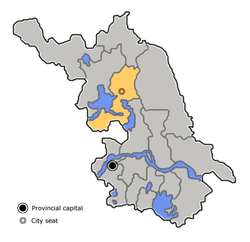 Location of Huai'an City (yellow) in Jiangsu | |
 Huai'an Location of the city center in Jiangsu 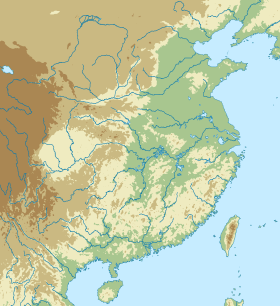 Huai'an Huai'an (Eastern China) 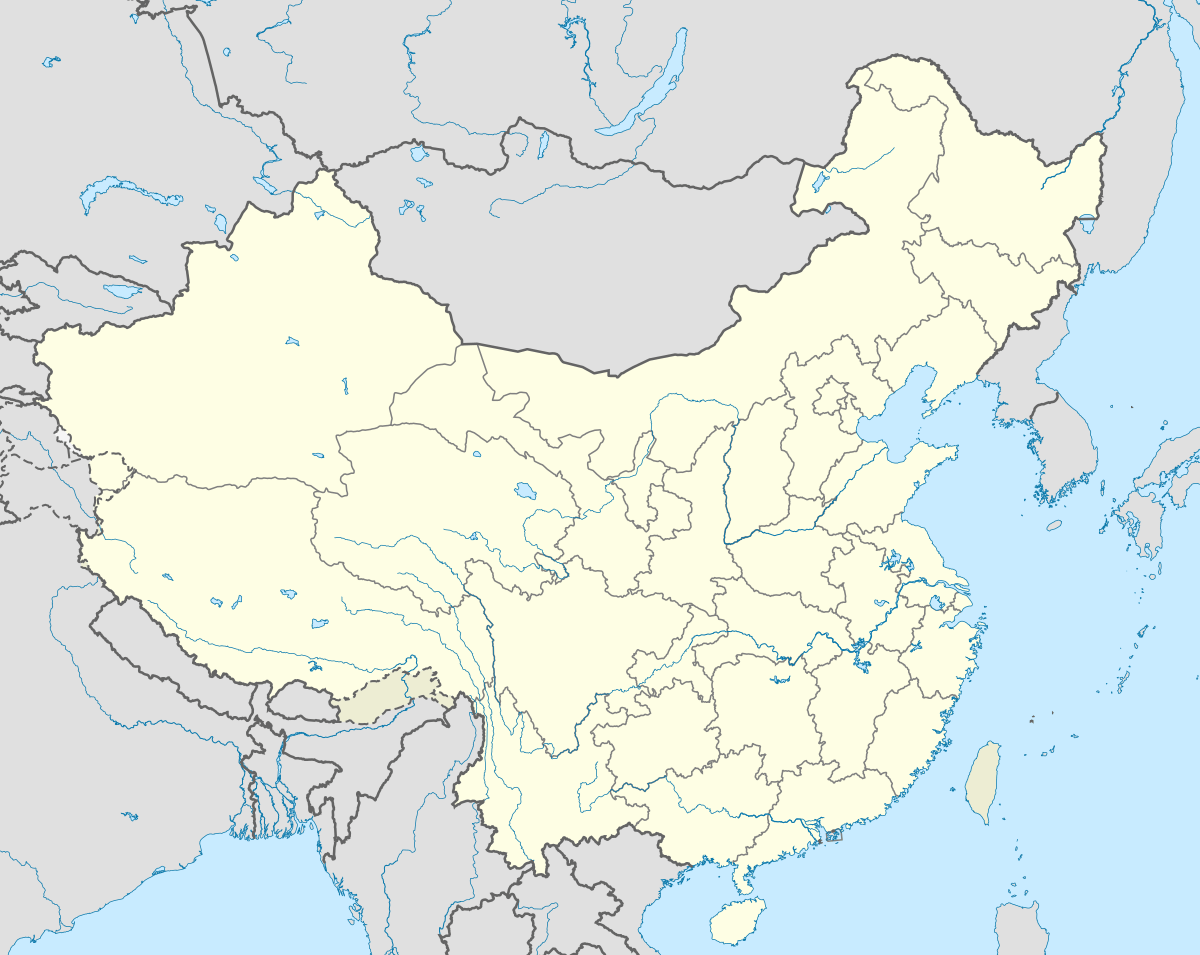 Huai'an Huai'an (China) | |
| Coordinates (Huai'an municipal government): 33°33′04″N 119°06′47″E | |
| Country | People's Republic of China |
| Province | Jiangsu |
| Municipal seat | Huai'an District |
| Government | |
| • Mayor | Hui Jianlin (惠建林) |
| Area | |
| • Prefecture-level city | 10,072 km2 (3,889 sq mi) |
| • Urban | 3,130 km2 (1,210 sq mi) |
| • Metro | 3,130 km2 (1,210 sq mi) |
| Population (2010 census) | |
| • Prefecture-level city | 4,799,889 |
| • Urban | 2,494,013 |
| • Urban density | 800/km2 (2,100/sq mi) |
| • Metro | 2,494,013 |
| • Metro density | 800/km2 (2,100/sq mi) |
| Time zone | UTC+8 (China Standard) |
| Postal code | 223000, 223200, 223300 (Urban center) 211600, 211700, 223100, 223400 (Other areas) (Other areas) |
| Area code(s) | 517 |
| ISO 3166 code | CN-JS-08 |
| GDP | ¥245.54 billion (2014) |
| GDP per capita | ¥50,736 (2014) |
| Major Nationalities | Han |
| County-level divisions | 8 |
| Township-level divisions | 127 |
| License Plate Prefix | 苏H |
| Website | www |

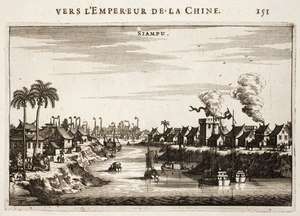
As of the 2010 census, the municipality had 4,799,889 inhabitants, of whom 2,494,013 lived in four urban districts.
Geography
Most parts of the Huai'an city area lie in the Jianghuai Plain, whose landscape tends to be flat. There are a few hills inside Xuyi County, and the highest altitude in Huai'an is 200m. Huai'an is notable for its large number of lakes, rivers, and canals. The most famous waterways include the Beijing-Hangzhou Grand Canal and the Huai River. Hongze Lake, the fourth largest freshwater lake in China, is to the southwest of Huai'an city. Towards the south, there are also several smaller lakes.
Administration
The prefecture-level city of Huai'an administers 7 county-level divisions, including 4 districts and 3 counties.
These are further divided into 127 township-level divisions, including 84 towns, 33 townships and 10 subdistricts.
| Map | |||||
|---|---|---|---|---|---|
| Subdivision | Simplified Chinese | Hanyu Pinyin | Population (2010) | Area (km2) | Density (/km2) |
| City Proper | |||||
| Qingjiangpu District | 清江浦区 | Qīngjiāngpǔ Qū | 860,185 | 443.05 | 1,941.51 |
| Suburban | |||||
| Huai'an District | 淮安区 | Huáiān Qū | 984,601 | 1,452.30 | 677.96 |
| Huaiyin District | 淮阴区 | Huáiyīn Qū | 788,634 | 1,307.24 | 603.28 |
| Hongze District | 洪泽区 | Hóngzé Qū | 326,365 | 1,273.41 | 256.29 |
| Rural | |||||
| Lianshui County | 涟水县 | Liánshuǐ Xiàn | 859,991 | 1,678.50 | 512.36 |
| Xuyi County | 盱眙县 | Xūyí xiàn | 658,830 | 2,497.31 | 263.82 |
| Jinhu County | 金湖县 | Jīnhú Xiàn | 321,283 | 1,377.73 | 233.20 |
| Total | 4,799,889 | 10,029.54 | 478.58 | ||
| defunct districts - Qinghe District & Qingpu District | |||||
History

Ancient China
The area of Huai'an spans an ancient canal of the Huai River, and the name of Huai'an expresses the residents' hope for a lastingly peaceful Huai River.
Pre-History
Chinese mythology recounts that Yu the Great, the Chinese leader with a legendary ability for flood control techniques, was constantly taming the Huai River here in the Huai'an area.
Traces of the activities of ancient Chinese living about 5000 to 6000 years ago have been found in the area. The most famous of these is the Qingliangang Hill Civilization (青莲岗文化).
Xia, Shang and Zhou Dynasty
The borough area had been properly developed, and led China in convenience of transportation and irrigation. The Gangou Drain (the section of the Grand Canal of China between Huaiyin and Yangzhou) connected the Yangtze River and the Huai River delta region. The Qian Road and Shan Road that traversed the region reached Southern and Northern China. Thus, Huaiyin was a critical area for several strong states in the Spring and Autumn period. The region was occupied by the Wu, Yue and Chu states, one after another.
Qin and Han Dynasty
After the Qin Dynasty consolidated all states in China, the County System was promoted throughout China. Huaiyin County (Matou Town of Huaiyin District today), Xuyi County (Northern town of Xuyi County today), and Dongyang (Maba of Xuyi County today) were built in the region.
In a movement of rebelling farmers during the later years of the Qin Dynasty, the people of Huai'an supported the rebel forces, including the famous militia leader Han Xin, who was highly honored for his bravery and meritorious deeds.
In the epoch of the West Han Dynasty, Huaipu County (Western Lianshui County today), Sheyang County (Southeast of Huai'an District today) and Fulin County (under the water of Hongze Lake today) were built.
During the Qin and Han Dynasties, great improvements, especially in irrigation, were made to agriculture and manufacturing. In the later years of the East Han Dynasty, the Governor of Guanglin, Cheng Deng, built the Gaojiayang Levees (Hongze Lake Levees today). These 30 miles of levees kept out flood waters and protected farmlands. He also built the Pofu Pool for farm irrigation. Iron-made apparatus and bull-farming were widespread. Although a few wars and battles took place, agriculture, transportation and logistics made fair progress. The highway built by the first Qin Emperor went through the region, and the West Way of Gaogou Drain, built by Cheng Deng, improved traffic between the Yangtze and the Huai River area.
Handicrafts and business also developed during this period, while culture and the arts were at high levels, as well. Home-teaching and private schools flourished during the Han Dynasty, and many famous artists appeared: for example, the Han-text composers Mei Chen and Mei Gao, and Chen Lin, one of the Seven Scholars of Jian'an.
Wei, Jin, and Southern and Northern Dynasties
Sui, Tang and Five Dynasties
Song and Yuan Dynasty
Ming and Qing Dynasty
The Ming Dynasty Ancestor Tomb (明祖陵) is located in Xuyi County, formerly Sizhou. This location was chosen for the tomb because the founder of the Ming Dynasty, Zhu Yuan Zhang (1328-1398), aka Hong Wu (1368-1398), was conceived in Xuyi town of Huai'an, and his grandfather died there, while his family was moving from Sizhou to Fengyang in Anhui. Three of the Hong Wu emperor's ancestors were buried here, his grandfather, his great grandfather, and his great great grandfather. Today the tomb site features a sacred way (shen dao) with one of the most impressive collections of Ming Dynasty stone statues in all of China.
In the reign of the Kangxi Emperor in the Qing dynasty the classical Qing Yan Garden was first built.
Republic of China
Since the People's Republic of China
Whole area of Huaiyin was occupied by Chinese communist army in December 1948 and became part of the territory of the People's Republic of China.
Qingjiang City
District of Huaiyin
District of Huaiyin was established on April 21, 1949, operating 10 counties, which were: Huaiyin, Huaibao (built of west parts of Huai'an and Baoyin section of the Grand Canal of China and county office located at town of Chahe), Siyang, Shuyang, Guanyun, Suqian, Suining, Xin'an (built of parts of Shuyang and Suqian and county office located at town of Xin'an), Pisui (built of southern Longhai Road of Pixian and northern Suining and county office located at town of Tushan) and Lianshui. The district office was at Huaiyin County.
Huaibao County was dissolved on May 12, 1950 to Huaiyin, Huai'an and Baoyin County (belonging to District of Yangzhou). And District of Huaiyin had 9 counties then.
The city area of Huaiyin County was separated as Qingjiang City on December 18, 1950 and District of Huaiyin then had 1 city and 9 counties.
With the establishment of Jiangsu Province in January 1953, District of Huaiyin was transferred to the province. Xin'an County was renamed to Xinyi County and county office of Pisui was moved to town of Yunhe. District of Huaiyin then had Qingjiang City and 9 counties, Huanyin, Lianshui, Guanyun, Siyang, Shuyang, Xinyi, Suqian, Pisui and Suining. The district office was sited at Qingjiang City. Later in the year, Suining, Pisui and Xinyi was given to District of Xuzhou and then District of Huaiyin had one city and six counties.
Qingjiang City was promoted to prefectural level of Jiangsu Province though was still operated by District of Huaiyin. Soon the district was joined by Huai'an County from District of Yancheng and in December by Sihong County from District of Suxian and Xuyi County from District of Chuxian in Anhui Province. The amount of all counties belonging to District of Huaiyin was 9.
In 1956 Hongze County was created from parts of Sihong, Huaiyin and Xuyi County with the county office sited at town of Gaoliangjian. The amount of counties then was 10.
In 1957 Xin'an Administrative Office was built from joint parts of Guanyun and Lianshui County and soon later renamed to Guannan County. The counties number reached 11.
Huaiyin County was merged in 1958 to Qingjiang City which was renamed to Huaiyin City and operated by District of Huaiyin, which had one city and 10 counties then.
However, in 1964, Huaiyin City was renamed back to Qingjiang City and Huaiyin County was restored but the county office was sited in Qingjiang City.
Xuyi County was transferred to District of Luhe in 1966 and District of Huaiyin then had one city and 10 counties.
Huaiyin Region
District of Huaiyin was renamed to Huaiyin Region in 1970 with the region office sited at Qingjiang City, operating Qingjiang City and 10 counties, which were Guanyun, Guannan, Shuyang, Suqian, Siyang, Lianshui, Huaiyin, Huai'an, Hongze and Sihong.
Xuyi County was returned by Luhe Region in 1971 as well as new transferred Jinhu County. Then one city and 12 counties belonged to Huaiyin Region.
In 1975 the office of Huaiyin County was relocated at the town of Wangyin.
Huaiyin City
Qingjiang City was renamed to Huaiyin City again in 1983 and operated directly by Jiangsu Province with the end of Huaiyin Region. Meanwhile, 11 counties, which were Guannan, Shuyang, Suqian, Siyang, Lianshui, Huaiyin, Sihong, Huai'an, Hongze, Xuyi and Jinhu, was transferred to new Huaiyin City while Guanyun County to Lianyungang City. The municipal area of Huaiyin City was split into two districts, Qinghe and Qingpu. Then 11 counties and 2 districts were belonging to Huaiyin City.
Suqian and Huai'an County was promoted to county-level cities in December 1987 by the order approved by Department of State, then renamed to Suqian and Huai'an City respectively. At the moment, Huaiyin City was operating 2 cities, 9 counties and 2 districts.
Suqian City was promoted to prefectural level of Jiangsu Province in 1996 and Shuyang, Siyang and Sihong County was transferred to Suqian City while Guannan County to Lianyungang City. After the adjustment, Huaiyin City had 5 counties, which were Huaiyin, Lianshui, Jinhu, Hongze and Xuyi, and 2 districts, Qinghe and Qingpu and was operating Huai'an City.
Huai'an City
By an order approved by Department of State on December 21, 2000, Huaiyin City was renamed Huai'an City with the city office sited at Qinghe District, while Huai'an District was established from the original Huai'an City with its district office in the town of Huaichen. Huaiyin District was established from the original Huaiyin County with its district office in the town of Wangyin. The county borders were also slightly modified.
Huai'an City now comprises four districts: Qinghe, Qingpu, Huai'an and Huaiyin; and three counties: Xuyi, Lianshui, and Jinhu. The Huai’an City Sports Centre Stadium is located in Huai’an. The football stadium has a capacity of 30,000, making it the largest sports venue by capacity in the city.
Climate
The climate in Huai'an is mild, and generally warm and temperate. Winters are much drier than in summer. The climate is classified as Cwa (humid subtropical climate with dry winters) by the Köppen climate classification
| Climate data for Huai'an | |||||||||||||
|---|---|---|---|---|---|---|---|---|---|---|---|---|---|
| Month | Jan | Feb | Mar | Apr | May | Jun | Jul | Aug | Sep | Oct | Nov | Dec | Year |
| Average high °C (°F) | 5.2 (41.4) |
6.9 (44.4) |
12.2 (54.0) |
19.1 (66.4) |
24.5 (76.1) |
28.8 (83.8) |
30.6 (87.1) |
30.6 (87.1) |
26.1 (79.0) |
21.2 (70.2) |
14.4 (57.9) |
7.9 (46.2) |
19.0 (66.1) |
| Daily mean °C (°F) | 1.1 (34.0) |
2.7 (36.9) |
7.5 (45.5) |
14.0 (57.2) |
19.4 (66.9) |
24.3 (75.7) |
27.2 (81.0) |
27.1 (80.8) |
22.1 (71.8) |
16.4 (61.5) |
9.7 (49.5) |
3.5 (38.3) |
14.6 (58.3) |
| Average low °C (°F) | −2.9 (26.8) |
−1.4 (29.5) |
2.8 (37.0) |
8.9 (48.0) |
14.4 (57.9) |
19.8 (67.6) |
23.9 (75.0) |
23.6 (74.5) |
18.1 (64.6) |
11.6 (52.9) |
5.1 (41.2) |
−0.8 (30.6) |
10.3 (50.5) |
| Average precipitation mm (inches) | 24 (0.9) |
31 (1.2) |
42 (1.7) |
51 (2.0) |
65 (2.6) |
108 (4.3) |
255 (10.0) |
159 (6.3) |
95 (3.7) |
38 (1.5) |
33 (1.3) |
22 (0.9) |
923 (36.4) |
| Source: Climate-Data.Org[1] | |||||||||||||
Transportation
Huai'an is served by the Xinyi-Changxing Railway, which has a station in Huaiyin District.
Being at the intersection of the Grand Canal and Huai River Huai'an is an important inland port.
The city is also served by nearby Huai'an Lianshui Airport. Currently the airport is served by China Eastern Airlines, which offers flights to Beijing-Capital, Chongqing, Guangzhou, Shanghai-Hongqiao, Shanghai-Pudong, Wenzhou, Wuhan, Xiamen, and Xi'an. Several other airlines offer domestic flights to cities such as Nanning and Zhengzhou. The airport is located 22 km (14 mi) from central Huai'an in Lianshui county.
Public transportation includes a tram system that connects the city center with the southeastern side of the city.
Notable people
- Han Xin (died 196 BC), late Qin Dynasty military general under Liu Bang, enfeoffed the Marquess of Huaiyin.
- Wu Cheng'en (1500–1582), Ming Dynasty novelist, author of the Journey to the West.
- Guan Tianpei (1780–1841), Chinese national hero; died during the Opium War.
- Zhou Enlai (1898–1976), prominent Communist Party of China leader, Premier of the People's Republic of China from 1949 till death.
- Ruth Bell Graham (1920–2007), born Ruth McCue Bell, wife of the famous evangelist Billy Graham
- Qiu Jian (1975), sport shooter, 2008 Beijing Summer Olympics gold medalist
- Zhao Shaolin, former mayor
- Bu Lianshi, (died 238) late Eastern Han Dynasty the favorite concubine of Sun Quan.
- Katherine Paterson (1932–), American novelist
- Li Yuanchao (1950-), former Vice President
Twin towns – sister cities
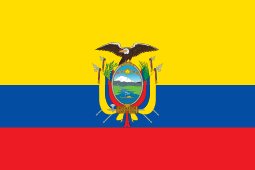



.svg.png)




References
- "Climate Data for Huai'an". Retrieved 2020-07-28.
- "Sister Cities". huaian.gov.cn. Huai'an. Retrieved 2020-07-12.
External links
| Wikimedia Commons has media related to Huai'an. |
- Government website of Huai'an (in Simplified Chinese)
- All things about Huai'an city (Huaianese.com in English)
- Huai'an comprehensive guide with open directory (Jiangsu.NET)
- Huaiyin Institute of Technology (ec.js.edu.cn)
